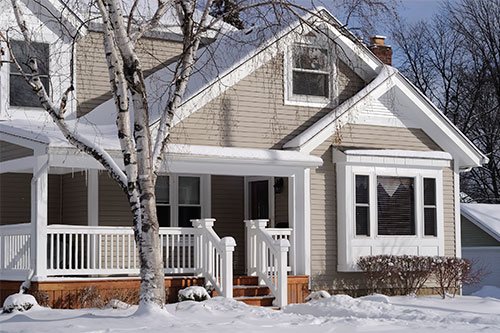Winter in the Kansas City metro area can be brutal. You might think that waiting until spring to paint your home’s exterior is a no-brainer. However, you do not have to wait. You just need an exterior paint that will stand up against cold temperatures (air temperature range can be from 35 to 50 degrees Fahrenheit) and weather conditions the exterior of your home faces during the winter months. Starting a painting project during the winter months is not always recommended, but not impossible, and the low temperatures are sometimes just a challenge during this time of year and not a roadblock.
Working with a painting contractor on cold weather exterior painting can help ensure that your exterior house painting project has excellent adhesion and a beautiful, lasting finish and is one of the most memorable home improvement projects you do no matter the time of year!
Here are some tips to give both your paint and paint supplies just a little TLC for best results.
Water, Oil or Latex Paint?
Oil-based paints are made with natural linseed oil or synthetic oils or resins. Should they get too cold, they can thicken up on you. You will need to use either mineral spirits or paint thinner as additives to create the consistency needed to paint in cold or minimum temperatures. Latex paints, on the other hand, have lower evaporation rates, so they take longer to thicken. Both latex and water-based paints freeze at 32 degrees.
Should your paint freeze, you’ll need to pitch it. The freeze-thaw cycle is no good for any type of paint. Paint gets lumpy, and thinning it won’t help if it has been through too many freeze-thaw cycles. At this point, thinning will just result in poor adhesion, low paint quality, and film cracking. You’re better off starting with fresh paint. This is part of why doing a paint project on the exterior of your house in lower temperatures during the wintertime is not always preferred like in the summer months, and why most people consider there to be a painting season. During these cold temperatures homeowners will often switch gears to interior painting for their cold weather painting projects.
The type of house exterior will also play a role in the type of paint you choose. If your house has aluminum siding, the paint will adhere differently than to a wood or metal home.
Remember that your exterior walls and exterior surface temperatures will be at least as cold as the air temperature, and it may be colder. This doesn’t mean that your vinyl siding, wood, or other substrate will be the same temperature as the air. Using an infrared measurement tool to check your substrate’s moisture and temperature is quick and inexpensive.
Finally, you probably will not have to use a primer before you paint, as many exterior paints now include some kind of priming agent. But if you do need a primer, choose a bonding primer that complements your paint – for instance, latex with latex primer.
Cold Weather Paint Basics
You need to pick a nice sunny day to paint once you have chosen your type of paint. The sun only shines for a few hours during winter days, so start painting during the mid-morning and work until early to midafternoon. You will want your paint to begin drying before the sun goes down and temperatures plummet. Windy days will hasten drying, which may lead to cracked paint or require you to paint multiple coats.
Start with the east side of the house and end with the west if you are painting with a crew. The sun rises in the east and sets in the west. You can split the paint job up into multiple days if you are a DIY-er or have a crew painting a larger house. You want to use the sun and the heat of the day to your advantage.
Should you need multiple coats of paint, you will need to allow plenty of drying time between the coats. You might need multiple hours or a couple of days before you apply a recoat.
Lastly, don’t forget to warm up your paint supplies. This includes brushes, rollers, and sprayers. Nylon or polyester supplies hold paint well in colder weather because they have stiffer bristles. Keep both paint and supplies inside the house if possible, and not in a shed.
Curing in the Common Cold
Paint can take a month to cure in warm temperatures. Watch your weather forecast carefully, and don’t paint if you have a major cold snap coming in. Just because paint is dry to the touch does not mean that it is cured beneath the surface. You don’t want to paint more than needed.
With common-sense prep work, winter exterior paint jobs are doable, even in the Midwest cold. The pros at Elite Painting KC provide quality service no matter how close to freezing it gets. Call us today to learn more about our painting services.


